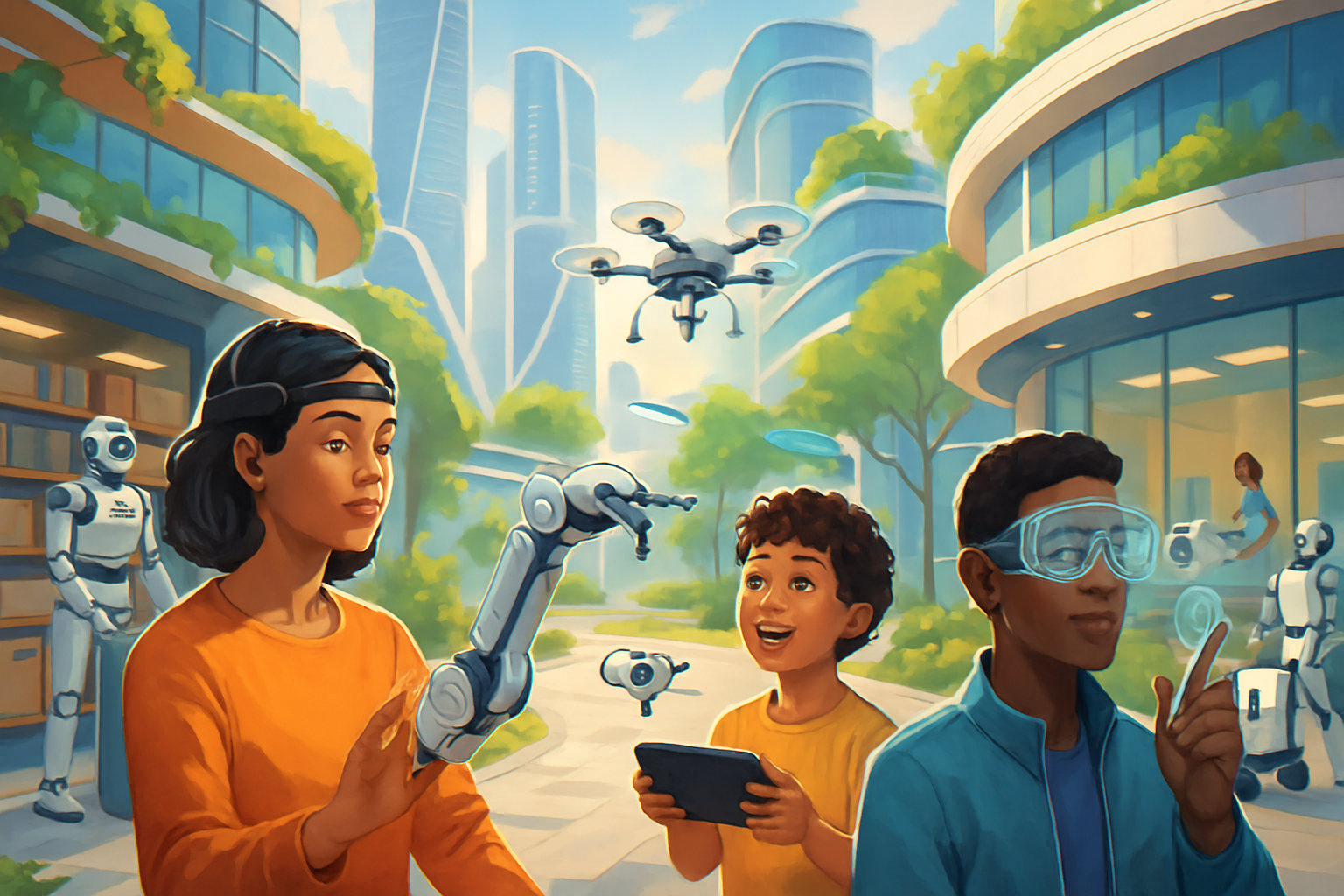How Drones, Brains, and Bots Are Rewiring the Real World: The 2025 Guide to AI-Powered Devices Transforming Everyday Life
Step into a future where your mind controls machines, drones adapt to your needs, and AI reshapes reality—are you ready to embrace the revolution that's redefining everyday life by 2025?

Welcome to the Age of Everyday Sci-Fi
Remember when controlling computers with your mind, chatting with robots, or sending drones to do your chores sounded like the stuff of very optimistic science fiction? Fast-forward to 2025: the future has crash-landed in your living room, your hospital, and maybe even your own body. AI-powered devices are no longer just for Silicon Valley demos—they’re rewiring the real world, and you’re living in the beta test.
“We’re not just building smarter gadgets—we’re creating a new nervous system for daily life.”
Brains, Bots, and Drones: The New Power Trio
1. Brainpower, Unplugged: Neural Implants in Action
In a clinical leap that’s as inspiring as it is mind-bending, paralyzed patients are now using brain-computer interfaces (BCIs) to control computers, robots, and even video games with pure thought. Companies like Neuralink have enabled seven individuals to move cursors, type, play Mario Kart, and even program—without lifting a finger. The device, embedded in the motor cortex, reads neural signals through a thousand electrodes. Training takes as little as 15 minutes, and users are clocking in up to 14 hours of mind-powered control daily, even from home.
- Near future: BCIs aim to restore speech, boost mobility, and become universal interfaces for communication—blurring the line between thought and action.
- Big question: When your brain can talk to the world, what happens to privacy, agency, and, well, your sense of self?
2. Drones with Instincts: From Warehouses to Wild Skies
Drones have grown up. At IKEA’s Maryland warehouse, swarms of autonomous, AI-powered drones now buzz alongside employees, counting inventory and finding misplaced items with superhuman accuracy. These mechanical colleagues don’t need sleep—they operate 24/7, and they’re getting smarter by the day.
The innovation doesn’t stop there. Enter neuromorphic drones: these flying machines use event-based vision (think: seeing like a brain, not a camera), spiking neural networks, and natural language processing. In real-world tests, they translate human speech into flight plans, dodge obstacles, and adapt in real-time—no joystick required.
- Why it matters: Neuromorphic vision means drones can react faster, save energy, and navigate unpredictable environments—a must for disaster response, deliveries, and even your next party’s aerial photos.
- Fun fact: The Parrot Bebop2 quadrotor is now a testbed for these brain-inspired flights.
3. Robots in the Real World: From Hospitals to Home
Robots aren’t just rolling around labs anymore. Thanks to advances in AI and the seamless fusion of robotics with the Internet of Things (IoT), we’re seeing bots in warehouses, hospitals, and even agriculture.
- Warehouse wonders: Robots paired with AI optimize inventory, handle logistics, and reduce errors—sometimes working side-by-side with humans (and drones!).
- Healthcare heroes: From cloud-connected surgical robots to mobile assistants, AI-powered robots are making healthcare smarter, safer, and more responsive.
- Farm-fresh automation: IoT-robotics hybrids monitor crops, deliver nutrients, and even herd livestock with a precision that would make any shepherd blush.
From Headlines to Hands-On: What It Means for You
It’s easy to feel like these breakthroughs are happening in some distant, futuristic bubble. But the reality? They’re quietly (and sometimes not-so-quietly) transforming daily life for millions:
- Accessibility revolution: BCIs offer new independence for those with disabilities—think controlling your home, your wheelchair, or your computer with a thought.
- Smarter shopping and logistics: AI robots and drones mean faster deliveries, fewer lost packages, and less time spent hunting for that missing IKEA bookshelf piece.
- Health and well-being: Robot-assisted care, AI-powered diagnostics, and even disease-detecting bots are raising the bar for healthcare everywhere.
- Everyday convenience: Expect more smart home devices, security bots, and personal assistants—all quietly stitched together by AI and robotics.
“If you’re not already living with AI-powered devices, chances are you will be soon. The only question is: Will you notice?”
Big Challenges, Big Questions
No grand adventure is complete without a few dragons. As AI, robotics, and neural tech blend into daily life, we face new puzzles:
- Privacy & Security: If your brainwaves and your fridge are both online, who’s protecting your data?
- Trust & Transparency: Robots that help in hospitals or drive your car must be explainable—not just smart. How do we keep humans in the loop?
- Ethics & Equity: Who gets access to these life-changing technologies? Are we building a future for everyone, or just the lucky few?
- Human Identity: When your mind can control machines, what does it mean to be "you"?
2025 and Beyond: How to Stay Ahead (and Have Fun Doing It)
Ready to ride the AI-powered wave instead of getting swept away? Here’s how to stay curious, critical, and connected:
- Stay informed. Follow trusted news sources, subscribe to smart blogs (like ours!), and never stop asking "why?" and "how?"
- Test the tech. Don’t just read—try out smart home devices, experiment with robotics kits, or visit a local makerspace. The best way to learn is hands-on.
- Ask hard questions. Push for transparency, ethical use, and inclusive design in every device you buy or use.
- Join the conversation. The future is being built in public—add your voice, your ideas, and your concerns.
“The most powerful technology in your life is the one you help shape. Don’t just watch—participate.”
Join the Funaix Insider Community
Want more stories, deep dives, and lively debates about the robots, drones, and brainy gadgets changing your world? Subscribe to Funaix for free—and become part of the conversation. Only subscribers can comment, share insights, and help guide our future coverage. (Plus, it’s free—at least for now. Your future self will thank you.)
Ready to help shape the next era of smart living? Join us here.
Published on August 19, 2025 — Written for the Funaix community




